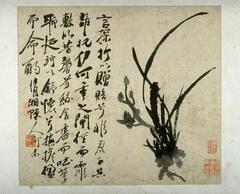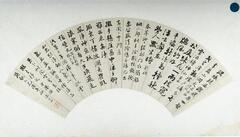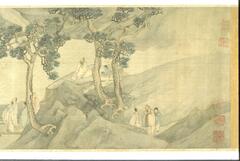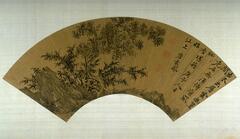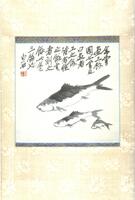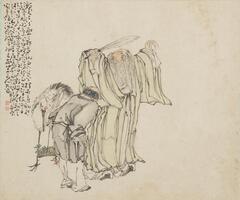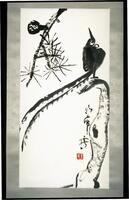11 Items in this Learning Collection
Collection Object
Collection Object
Collection Object
Collection Object
Collection Object
Collection Object
Collection Object
Collection Object
Collection Object
Collection Object
Copyright
All Rights Reserved
()
Orchids Room
Accession Number
1968/2.25
Title
Orchids Room
Artist(s)
Unge (Taigan)
Object Creation Date
1823
Medium & Support
handscroll, ink on paper
Dimensions
11 in x 264 in (27.9 cm x 670.6 cm)
Credit Line
Museum purchase made possible by the Margaret Watson Parker Art Collection Fund
Label copy
Copies and Invention in East Asia (August 17, 2019 - January 5, 2020)
A scholar-monk and highly skilled calligrapher, Unge also took up the literati motif of orchids. His close friendships with many of the leading literati painters and calligraphers in Japan are documented in this important handscroll. Shinozaki Shōchiku (1781–1851), a well-known Confucian scholar, and calligrapher, brushed the title sheet to the scroll, while six other artists added comments at the end. Rai San’yō (1781–1832), another important Confucian scholar, wrote the first two. From these inscriptions we know that Unge painted the orchid and bamboo during a gathering with his friends and then solicited comments from them that would provide him with comfort and encouragement when they were not together. His friends compare Unge to the plants, admiring his integrity and independence. They also appreciate how his free brushwork conveys the sublime beauty of bamboo and orchids. Here text and image are inextricably woven together, recording an ongoing exchange between friends.
Gallery Rotation Spring/Summer 2012
Unge (Taigan)
Japan, 1773–1850
Orchid Room
Edo period (1615–1868)
1823
Handscroll, ink on paper
Museum purchase made possible by the Margaret Watson Parker Art Collection Fund, 1968/2.25
Unge was a native of Kumamoto in Kyûshû, the westernmost of the Japanese islands. Born into a family of Buddhist priests, as a young man he was sent to Kyoto to study. He settled into a comfortable life as a scholar-monk, becoming close friends with many of the leading painters trained in the Chinese literati (amateur scholar-artist) style as well as a highly skilled calligrapher. Those friendships are documented in this important handscroll with five clusters of orchids. The scroll was meant to be unrolled and then rerolled slowly from right to left, so that only a small section could be seen at any time, as displayed here. Shinozaki ShÔchiku, a well-known Confucian scholar and calligrapher, brushed the title sheet that opens the scroll, while six other artists added comments at the end. Text and image are inextricably woven together, recording an ongoing exchange between friends.
The materials of this scroll provide clues about its origins. The work is executed on sheets of paper rather than silk, and these are haphazardly-sized and glued together, suggesting a more humble audience. A handscroll for a more elite viewer (such as an official or the imperial court) would be comprised of uniform pieces of silk.
Subject matter
Unge was a native of Kumamoto in Ky?sh?, the westernmost of the Japanese islands. Born into a family of Buddhist priests, he was sent to Kyoto to study as a young man. He settled into a comfortable life as a monk scholar, and became close friends with many of the leading literati painters trained in the Chinese style as well as a highly skilled calligrapher of his day. Those friendships are documented in this important handscroll. Unge painted five clusters of orchids in this scroll, only one of which is visible in this short section. Shinozaki Sh?chiku, a well-known Confucian scholar and calligrapher brushed the title sheet that opens the scroll, while six other artists added comments at the end. Text and image are inextricably woven together, recording stimulus and response as an ongoing exchange between friends.
The materiality of the handscroll is intricately tied to its intended use. For example, the handscroll is meant to be unrolled and then rerolled slowly from right to left. This way of reading the handscroll gives the author(s) great control over how the intended viewer or viewers are presented with the art and calligraphy. Naturally, this authorial control has a considerable impact on the way in which it is read and appreciated. Additionally, since the work is executed on paper rather than silk, this suggests a more humble origin. This is further supported by the haphazard sizes of individual sheets of paper that are glued together. A more official or imperial handscroll would have uniform pieces of silk, which provides important clues to the provenance of pieces such as this one.
Physical Description
Horizontally oriented. Begins with two large characters then a series of folliage imagery proceeded by calligraphy. Ink on paper, hand scroll.
Primary Object Classification
Painting
Primary Object Type
handscroll
Collection Area
Asian
Rights
If you are interested in using an image for a publication, please visit http://umma.umich.edu/request-image for more information and to fill out the online Image Rights and Reproductions Request Form. Keywords
Birds
bamboo (material)
calligraphy (process)
grass (plant material)
handscroll
handscrolls
painting
1968/2.25
Title
Orchids Room
Artist(s)
Unge (Taigan)
Object Creation Date
1823
Medium & Support
handscroll, ink on paper
Dimensions
11 in x 264 in (27.9 cm x 670.6 cm)
Credit Line
Museum purchase made possible by the Margaret Watson Parker Art Collection Fund
Label copy
Copies and Invention in East Asia (August 17, 2019 - January 5, 2020)
A scholar-monk and highly skilled calligrapher, Unge also took up the literati motif of orchids. His close friendships with many of the leading literati painters and calligraphers in Japan are documented in this important handscroll. Shinozaki Shōchiku (1781–1851), a well-known Confucian scholar, and calligrapher, brushed the title sheet to the scroll, while six other artists added comments at the end. Rai San’yō (1781–1832), another important Confucian scholar, wrote the first two. From these inscriptions we know that Unge painted the orchid and bamboo during a gathering with his friends and then solicited comments from them that would provide him with comfort and encouragement when they were not together. His friends compare Unge to the plants, admiring his integrity and independence. They also appreciate how his free brushwork conveys the sublime beauty of bamboo and orchids. Here text and image are inextricably woven together, recording an ongoing exchange between friends.
Gallery Rotation Spring/Summer 2012
Unge (Taigan)
Japan, 1773–1850
Orchid Room
Edo period (1615–1868)
1823
Handscroll, ink on paper
Museum purchase made possible by the Margaret Watson Parker Art Collection Fund, 1968/2.25
Unge was a native of Kumamoto in Kyûshû, the westernmost of the Japanese islands. Born into a family of Buddhist priests, as a young man he was sent to Kyoto to study. He settled into a comfortable life as a scholar-monk, becoming close friends with many of the leading painters trained in the Chinese literati (amateur scholar-artist) style as well as a highly skilled calligrapher. Those friendships are documented in this important handscroll with five clusters of orchids. The scroll was meant to be unrolled and then rerolled slowly from right to left, so that only a small section could be seen at any time, as displayed here. Shinozaki ShÔchiku, a well-known Confucian scholar and calligrapher, brushed the title sheet that opens the scroll, while six other artists added comments at the end. Text and image are inextricably woven together, recording an ongoing exchange between friends.
The materials of this scroll provide clues about its origins. The work is executed on sheets of paper rather than silk, and these are haphazardly-sized and glued together, suggesting a more humble audience. A handscroll for a more elite viewer (such as an official or the imperial court) would be comprised of uniform pieces of silk.
Subject matter
Unge was a native of Kumamoto in Ky?sh?, the westernmost of the Japanese islands. Born into a family of Buddhist priests, he was sent to Kyoto to study as a young man. He settled into a comfortable life as a monk scholar, and became close friends with many of the leading literati painters trained in the Chinese style as well as a highly skilled calligrapher of his day. Those friendships are documented in this important handscroll. Unge painted five clusters of orchids in this scroll, only one of which is visible in this short section. Shinozaki Sh?chiku, a well-known Confucian scholar and calligrapher brushed the title sheet that opens the scroll, while six other artists added comments at the end. Text and image are inextricably woven together, recording stimulus and response as an ongoing exchange between friends.
The materiality of the handscroll is intricately tied to its intended use. For example, the handscroll is meant to be unrolled and then rerolled slowly from right to left. This way of reading the handscroll gives the author(s) great control over how the intended viewer or viewers are presented with the art and calligraphy. Naturally, this authorial control has a considerable impact on the way in which it is read and appreciated. Additionally, since the work is executed on paper rather than silk, this suggests a more humble origin. This is further supported by the haphazard sizes of individual sheets of paper that are glued together. A more official or imperial handscroll would have uniform pieces of silk, which provides important clues to the provenance of pieces such as this one.
Physical Description
Horizontally oriented. Begins with two large characters then a series of folliage imagery proceeded by calligraphy. Ink on paper, hand scroll.
Primary Object Classification
Painting
Primary Object Type
handscroll
Collection Area
Asian
Rights
If you are interested in using an image for a publication, please visit http://umma.umich.edu/request-image for more information and to fill out the online Image Rights and Reproductions Request Form. Keywords
Birds
bamboo (material)
calligraphy (process)
grass (plant material)
handscroll
handscrolls
painting
